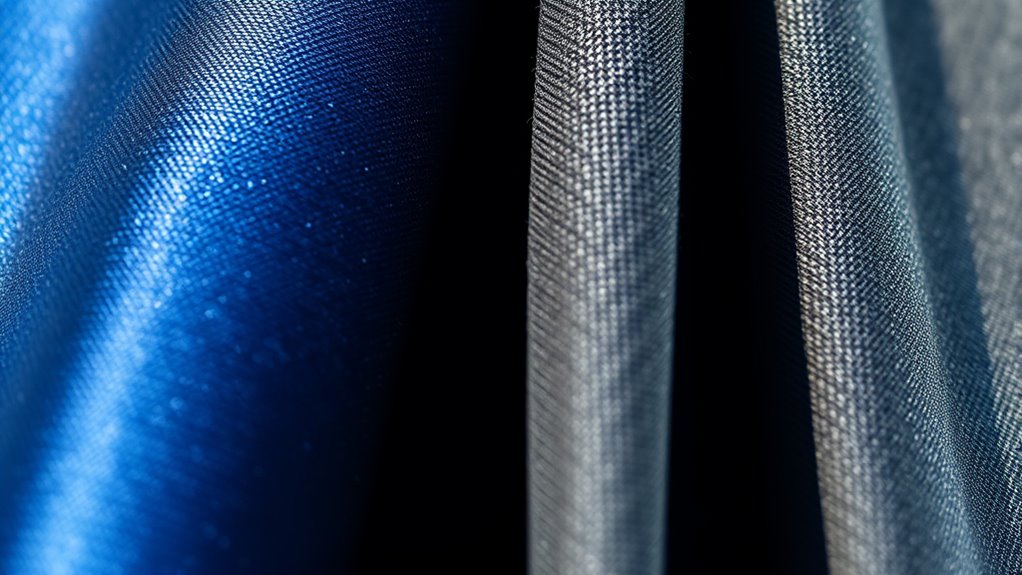Metamerism is the sneaky reason your outfit seems mismatched in sunlight or different lighting. It happens because fabrics that match perfectly indoors can reflect light differently outdoors or under varied lighting, causing color shifts. This occurs due to pigment differences and how fabrics absorb and reflect light at different wavelengths. If you want to understand how lighting affects your clothes and what you can do about it, there’s more to discover below.
Key Takeaways
- Metamerism causes fabrics to look matching indoors but mismatch in sunlight due to pigment differences.
- Lighting changes, especially sunlight’s shifting color temperature, affect how colors are perceived, revealing mismatches.
- Fabrics with different dye compositions reflect light differently under various lighting, leading to outfit mismatches.
- Variations in fabric texture and reflectance can make colors appear aligned indoors but separate in sunlight.
- Comparing clothing in natural light before purchase helps identify and prevent metameric mismatches.
What Is Metamerism and How Does It Work?

Have you ever noticed how a fabric’s color seems to change under different lighting? That’s metamerism in action. It occurs when two fabrics appear matching in one light but mismatch in another due to differences in their pigment composition. To understand this, scientists use spectrophotometer analysis, which measures how fabrics reflect light across various wavelengths. This analysis reveals the subtle differences in pigment composition that cause the color shift. Basically, metamerism happens because different pigment mixes reflect light differently depending on the lighting conditions. By studying these pigment variations through spectrophotometer data, you can predict when colors might mismatch. This helps designers and manufacturers ensure consistent color appearance, reducing surprises when outfits are viewed under different light sources. Additionally, understanding light reflectance can assist in developing fabrics with minimized metameric effects.
How Lighting Conditions Affect Color Perception

Lighting conditions play a crucial role in how you perceive the color of fabrics and outfits. Your eyes interpret colors based on the light’s color temperature and ambient lighting. Under warm lighting, with a lower color temperature, colors may appear softer or more yellowish, making cool tones seem muted. In contrast, cool lighting with a higher color temperature can enhance blue and green hues, making warm colors look dull or washed out. Natural sunlight varies throughout the day, shifting from warm to cool tones, which can cause your outfit’s colors to look different depending on the time and environment. Understanding how lighting influences perception helps you anticipate color mismatches and choose outfits that look consistent across various lighting conditions. Additionally, color perception can be affected by individual differences in eyesight, further complicating how colors appear under different lights.
Common Situations Where Mismatched Colors Appear

Mismatched colors often become noticeable in everyday situations where lighting varies unexpectedly. For example, when you wear a shirt and pants with similar colors but different fabric types, fabric differences can alter how their colors appear under different lights. In daylight, the fabrics might look perfectly coordinated, but indoors or in artificial light, they may seem off. This is because different textiles reflect and absorb light differently, affecting color matching. Another common situation is mixing materials like cotton and polyester, which react differently to sunlight and indoor lighting. These subtle variations can create the illusion of mismatched colors, even when your clothing was carefully coordinated. Additionally, understanding how fabric reflectance influences color perception can help you better anticipate and avoid surprising mismatches in various lighting conditions.
Recognizing Metamerism in Clothing and Design

Recognizing metamerism in clothing and design involves paying close attention to how colors appear under different conditions. You might notice that a shirt looks perfect indoors but changes hue outdoors. To spot it, observe:
- Variations in fabric texture, which can influence how light reflects and alters perceived color
- Differences in dye absorption, causing colors to shift under different lighting
- Subtle mismatches between fabrics that seem identical but react differently to light
- The lighting environment can significantly impact how colors are perceived, revealing the presence of metamerism.
These factors make some colors seem aligned in one setting but mismatched in another. By closely examining these details, you can identify when metamerism is at play. Recognizing these cues helps you understand why certain outfits look off under sunlight, even if they seem perfect indoors.
Tips to Minimize Color Discrepancies in Your Wardrobe

To reduce color discrepancies in your wardrobe, start by choosing fabrics and dyes carefully. Proper fabric selection is essential because different materials reflect light uniquely, affecting how colors appear under various lighting conditions. Opt for natural fibers like cotton or wool, which tend to hold dye more consistently than synthetic fabrics. Additionally, consider color calibration by comparing garments under different lighting—indoor, daylight, and fluorescent—to ensure they match well. When shopping, hold clothes side by side in natural light to assess color harmony. Washing clothes together can also help maintain consistent appearance over time by preventing fading or uneven dyeing. Paying attention to fabric quality and verifying colors in various lighting, along with understanding metamerism, will help you minimize discrepancies and keep your wardrobe looking coordinated, no matter the environment.
The Science Behind Color Matching and Visual Illusions

Understanding the science behind color matching involves exploring how our eyes perceive colors and how various factors can influence that perception. Your eyes interpret color based on light reflected from surfaces, which depends on material reflectance and color stability. Several elements can create visual illusions, making colors seem different under varying lighting conditions. For example, different fabrics may reflect light uniquely, altering perceived color. When you compare colors side by side, subtle differences in material reflectance can cause mismatches, especially in sunlight. Visual illusions like metamerism occur because:
- Two fabrics reflect light differently despite looking identical indoors
- Bright sunlight highlights differences in color stability
- Colors appear inconsistent due to the angle and intensity of light
- Material reflectance plays a crucial role in how colors are perceived under different lighting conditions
Understanding these factors helps you grasp why your outfit may seem mismatched in certain lighting.
Frequently Asked Questions
Can Metamerism Be Completely Avoided With Certain Fabrics or Materials?
You can’t completely avoid metamerism with certain fabrics or materials, but some options help reduce it. Fabric treatments and choosing specific material compositions, like dyes that minimize color shift, can lessen the effect. Look for fabrics designed with stable dyes or those tested for color consistency under different lighting. While you can’t eliminate metamerism entirely, selecting carefully treated fabrics and specific material compositions can markedly lessen mismatched appearances in sunlight.
How Does Metamerism Impact Professional Color Matching in Industries?
Imagine trying to match paint colors, only to find they look different under various lights—that’s how metamerism affects industry color matching. It challenges maintaining color consistency because fabrics or materials may appear perfect in the store but mismatch in different lighting conditions. This means professionals must use standardized lighting and color measurement tools to guarantee accurate color communication, preventing costly mistakes and ensuring products look perfect everywhere, anytime.
Are There Specific Tools or Technologies to Detect Metamerism Early?
You can detect metamerism early using tools like spectrophotometer analysis and digital colorimeters. These devices measure color precisely and compare spectra under different lighting conditions, helping you identify potential mismatches before they become noticeable. By employing these technologies, you guarantee consistent color matching across various environments, reducing surprises and maintaining quality standards in your projects.
Does Metamerism Affect Digital Screens or Only Physical Objects?
Think of digital screens as chameleons, changing their appearance with lighting. Metamerism can cause screen discrepancies, creating digital illusions that make colors look different under various lighting conditions. While it mostly affects physical objects, some displays may exhibit color shifts due to metamerism, especially with certain materials or lighting. So, yes, metamerism can impact digital screens, leading to subtle color mismatches just like it does with physical items.
Can Personal Eyesight Variations Influence Perception of Color Mismatches?
Your personal eyesight variations, like visual acuity and color sensitivity, can influence how you perceive color mismatches. If you have sharper vision, you might notice subtle differences more easily, while those with less sensitivity may not see the mismatch at all. These differences mean your perception of color can vary from others’, making it possible for you to see mismatches that someone else might overlook.
Conclusion
Next time your outfit seems off in sunlight, remember, it’s not always your eye playing tricks. Sometimes, subtle differences can hide behind the science of metamerism, reminding you that perfection isn’t always within reach. Embrace the quirks of perception, and let them inspire a little patience and curiosity. After all, the world’s most beautiful colors often reveal themselves gradually—reminding you that sometimes, it’s about appreciating the subtle nuances rather than chasing flawless matches.









